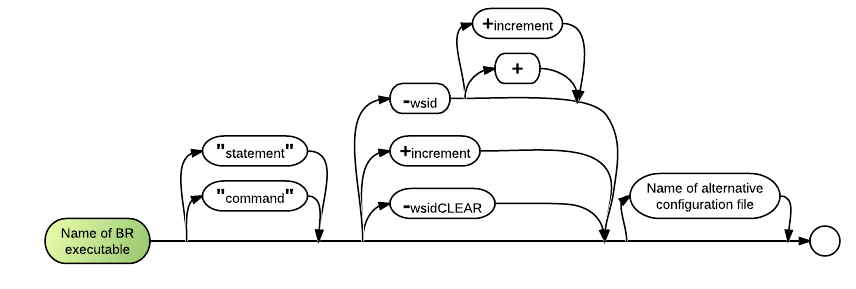Start-up Command
In order to modify the default behavior of BR after it starts, you may use a start-up command. It can be executed only from the host operating system.
Syntax
Parameters
The name of BR executable, in either uppercase or lowercase letters, must be specified.
A complete "statement" or "command" may follow the name of BR executable. It will be executed as soon as BR is entered. The use of quotation marks around the command or statement is not required, but it is highly recommended.
The -wsid parameter represents the workstation ID. It may be a number from 1 to 999. If no -WSID parameter is specified, BR automatically tries to assign a workstation ID of 1 to the session.
A plus symbol + may optionally follow the -wsid parameter to indicate that when the specified wsid is already in use, BR should increment accordingly until an available ID is found. If the plus symbol is followed by an increment parameter, it will be used when it is necessary to increment. The increment parameter may be any whole number from 0 to 999. If the plus symbol is used but increment is not specified, 1 is used as the incremental default. If no plus symbol is specified and the requested ID is already in use, an error results.
The name of alternative configuration file parameter identifies the name of an alternate BR configuration BRConfig.sys file. This configuration file can contain important information that helps customize a number of configurable BR and application options for the user. The actual specification must consist of a dash (-) followed by a path (optional) and file name. If a name of alternative configuration file is not specified, BR automatically looks for a file named BRConfig.sys and uses its contents as the configuration file.
@UserName parameter may also be used to override the windows environmental variable UserName in the Login_Name$ internal function.
Comments and Examples
As BR32.exe is executed from the operating system, it is operating system dependent. In the next example, BR is started on a Windows system. Immediately after BR starts up, the RUN command is executed and the MENU program begins to run:
BR32.exe "RUN MENU"
Consider this example for Windows:
- Click Start → Run
- Type in C:\BR\BR.exe -45 @alternateUser and press <ENTER>
The effect of the above command will be:
- BR will be started
- The workstation ID will be 45 (speceified by the -45 parameter)
- Instead of the currently logged in Windows user, an alternative name will be used, in this case alternateUser
The above command assumes that the BR executable is located in the directory C:\BR
The command in the next example causes BR to start up at the same time that it assigns a workstation ID of 42 and specifies altconfg.sys to be used as the BRConfig.sys file:
br32.exe -42 -altconfg.sys
The BR command in the next example causes a PROC command to be executed as soon as BR is started. It also assigns a WSID of 21 to the workstation, and it identifies ALT6.SYS as the alternate BRConfig.sys file:
BR32.exe "PROC START" -21 -ALT6.SYS
Defaults
- Do not load BR as a memory-resident task.
- Enter BR without executing a command or statement.
- Workstation ID assignment
- assign a workstation ID of 1 on single-user systems
- assign the workstation's hardware-dependent ID on Unix and Linux systems
- assign according to sign-on order on Windows systems.
- Access BRConfig.sys from the current directory.
- Use the specified WSID. If already in use, return an error.
- Use an increment of 1.
- Assume that the configuration file is named BRConfig.sys.
At startup the number of authorized users is displayed, in addition to the number of current users.
